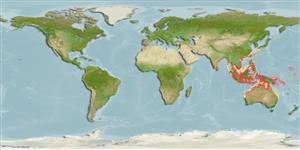Common names from other countries
Environment: milieu / climate zone / depth range / distribution range
Ecología
; salobre. Tropical
Indo-West Pacific: from the Andaman Sea to Indonesia; north to Viet Nam and the Philippines.
Length at first maturity / Tamaño / Peso / Age
Maturity: Lm ? range ? - ? cm Max length : 5.5 cm SHL macho / no sexado; (Ref. 349); common length : 4.5 cm SHL macho / no sexado; (Ref. 349)
Collected for food in many areas of Southeast Asia (Ref. 349). Often climbing up the trees to feed on algae growing at the roots and stems. Commonly found together with Cerithidea obtusa (Ref. 349).
Life cycle and mating behavior
Madurez | Reproducción | Puesta | Huevos | Fecundidad | Larva
Members of the order Neotaenioglossa are mostly gonochoric and broadcast spawners. Life cycle: Embryos develop into planktonic trocophore larvae and later into juvenile veligers before becoming fully grown adults.
Poutiers, J.M. 1998. (Ref. 349)
IUCN Red List Status (Ref. 130435)
CITES status (Ref. 108899)
Not Evaluated
Not Evaluated
Threat to humans
Harmless
Human uses
| FishSource |
Herramientas
Más información
Age/SizeCrecimientoLength-weightLength-lengthMorfologíaLarvaAbundancia
Fuentes de Internet
Estimates based on models
Preferred temperature
(Ref.
115969): 27.6 - 29.3, mean 28.7 (based on 404 cells).
Vulnerability
Low vulnerability (10 of 100).
Price category
Unknown.
